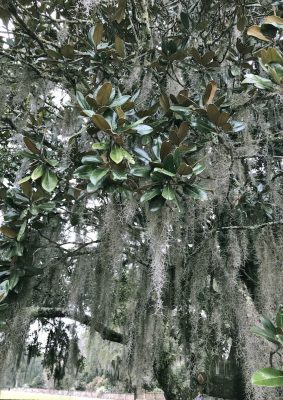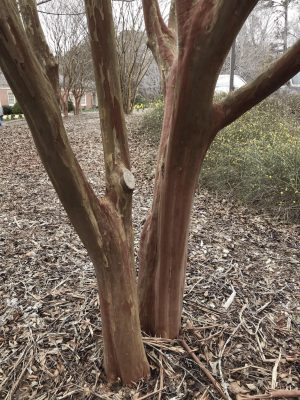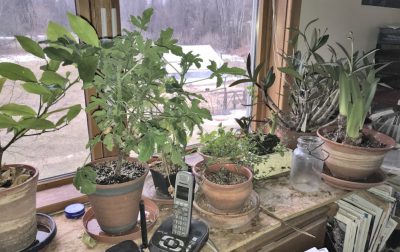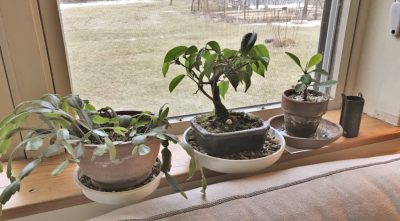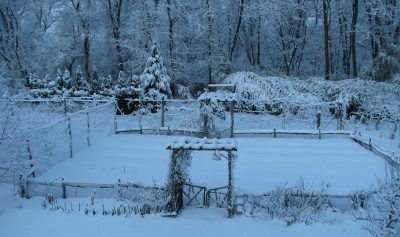SOW NOW?
Next Year’s ‘Chokes
Ahh, such a leisurely time of year to sow seeds. And for some of them, I don’t care if they don’t sprout for months. You might wonder: Why sow now; why so laid back?
I’ll start with artichoke, from whose seeds I did want to see sprouts soon. And I did. The seeds germinate readily. Right now, a few small seedlings are growing, each in its own “cell” of a seed flat, enjoying the cool, sunny weather.
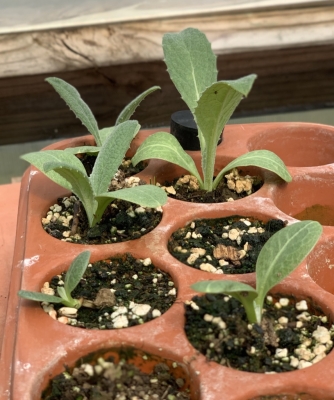
Artichoke is a perennial whose natural life cycle is (usually) to grow leaves its first year, then edible buds its second year and for a few years hence. Especially in colder regions, artichokes can sometimes grown from seed like annuals, with a wrinkle.
To make that transition from growing only leaves to growing flower buds, the plants need to get vernalized, that is, to experience some winter cold. Except that winter cold here in the Hudson Valley (and everywhere else colder than Hardiness Zone 7) will do the plants in. So we cold-climate gardeners need to trick the plants into feeling like they experienced winter cold, just not our winters’ depth of cold.
When growing artichokes like annuals, from seed sown in spring, you make “winter” by exposing the young, growing seedlings to cool, but not frigid, temperatures (32-50°F) for a couple of weeks. The problem with this method is that the plants are fairly small when they get this signal that “winter” is over. In my experience, these small plants make commensurately small buds for harvest.
I’m lucky enough to have a greenhouse that gets very cool in winter, but not below freezing. My young artichoke plants will continue to grow very large though the very extended “autumn” weather in the greenhouse. In midwinter, they should get plenty of chilling. Come spring, after frost danger is past, I’ll plant out the large plants to, I hope, make large, fat buds.
I got this idea from growing cardoon, which is essentially the same as artichoke, except it’s grown for its large leaf stalks.
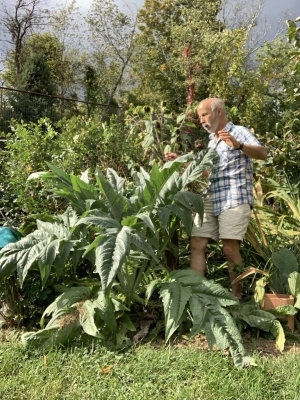
Or it’s grown as a flower, in which case it would require the same conditions as artichoke to make flowers. I don’t like cardoon as a vegetable but do like it as a flower, so last year, around now, I sowed cardoon seeds and grew the seedlings in the greenhouse just as I’ve described for artichoke. The result was big, fat, beautiful, blue flowers. I expect the same, except I’ll harvest the artichoke buds before they open.
Actually, I grew two cardoon plants, and for some reason one of them grew only leaves all summer, and is still growing them, the olive-green leaves each rising from ground level in a four-foot-high-whorl.
More Hucks’
A couple of months ago I collected huckleberry seeds from my huckleberry plant and sowed them. As expected, they still haven’t sprouted. They weren’t expected to sprout, at least not until they were “stratified.”
Like artichoke, huckleberry (Gaylussaccia baccata) needs to feel that winter is over, in this case before its seeds will sprout. Stratification, as this cold exposure is called, prevents small seedlings from being killed by winter cold after sprouting in late summer or autumn.
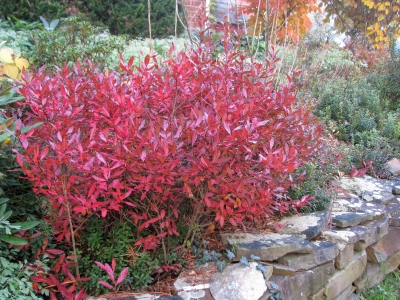
My huckleberry plant in fall
Again, it’s a certain duration of cool (32-50°F) temperatures that do the trick. Under natural conditions, these chilling requirements are fulfilled in late autumn and/or in spring. In this case, colder temperatures would do no harm, but would not put any hours into the “chilling bank.” Once the “chilling bank” has been filled, the seeds await warm enough temperatures to sprout.
(For more details and wrinkles about seed germination, see my latest book, The Ever Curious Gardener: Using a Little Natural Science for a Much Better Garden.)
The pot of huckleberry seeds has been sitting outdoors, covered, since they were sown. If I want earlier sprouting, I’ll bring the pot into the greenhouse in winter.
Ramping Up
I collected seeds from my ramp plants about a month ago with an eye to increasing my holdings. You guessed it: Ramps also need cold. But given mere stratification, the seed will not germinate. The behavior of ramp seeds is a little different from huckleberry seeds in that ramp seeds have a double dormancy.
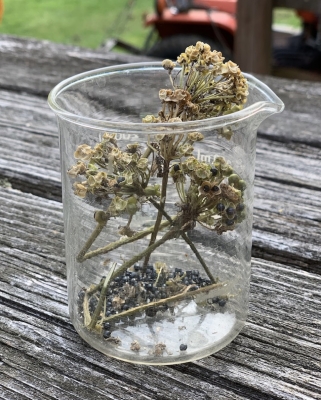
Roots need to grow before the shoots will sprout. That first stage requires a couple of months or so of warmth. Only after then can the second stage, shoot growth, begin, except that won’t occur until after a stratification period, with cool temperatures, again between 32-50°F.
Under natural conditions, ripe ramp seeds get their warm period before winter sets in and then are ready to sprout in spring. But further north, where seeds ripen later, that first stage, to get root growth underway, is delayed until the summer after the seeds drop. In that case, sprouts don’t poke above ground until their second spring.
I don’t want to wait that long so I sowed my ramp seeds in a seed flat which I’m keeping in a warm place for a couple of months. After that, I’ll move the flat to cooler temperatures. And then, come spring, sprouts — I hope.

My ramps mother plants

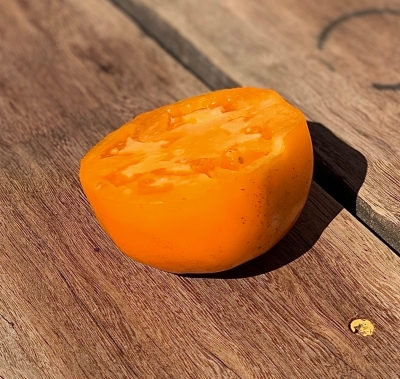

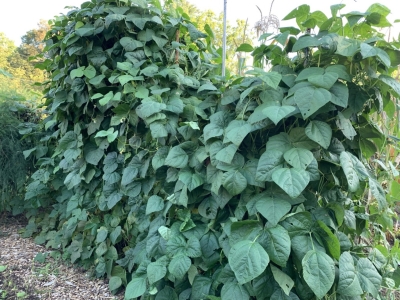 I guess two plants per pole, with poles about a foot apart, is too crowded. Next year: one plant per pole.
I guess two plants per pole, with poles about a foot apart, is too crowded. Next year: one plant per pole.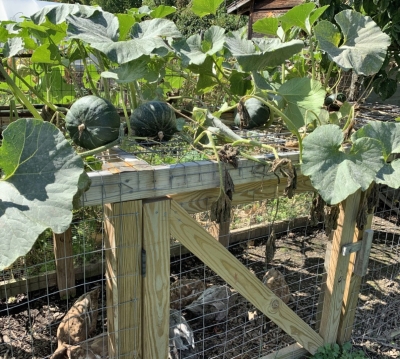
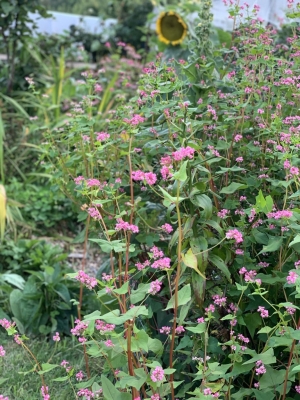
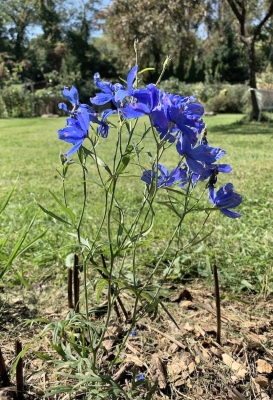
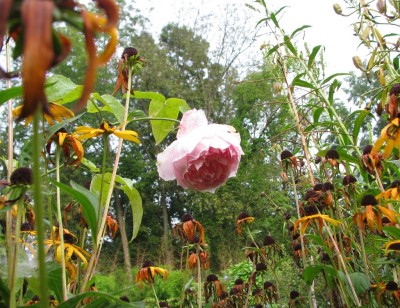
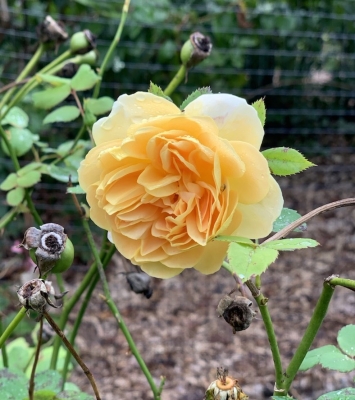
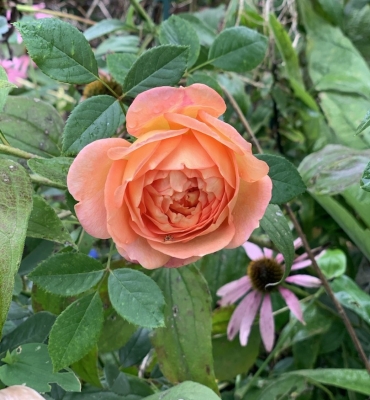
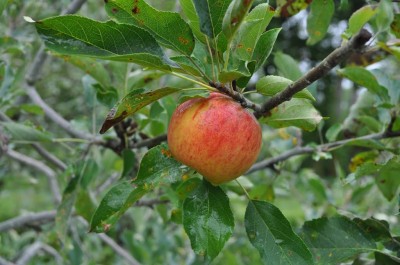


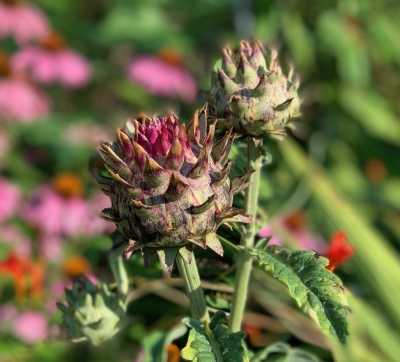
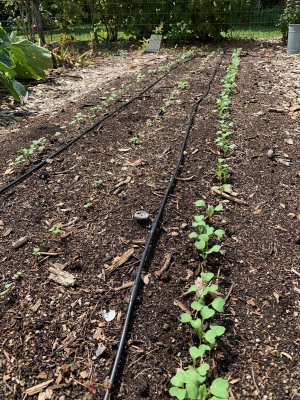
 The flavor hints of artichoke, a close relative. None the less, for me the flavor was awful and the stalks were tough. (Cardoon is usually covered to blanche them a few weeks before harvest. Blanching did not make mine more edible.)
The flavor hints of artichoke, a close relative. None the less, for me the flavor was awful and the stalks were tough. (Cardoon is usually covered to blanche them a few weeks before harvest. Blanching did not make mine more edible.)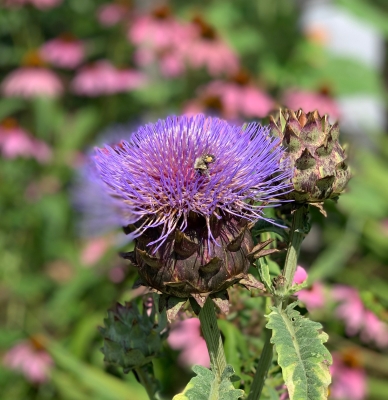
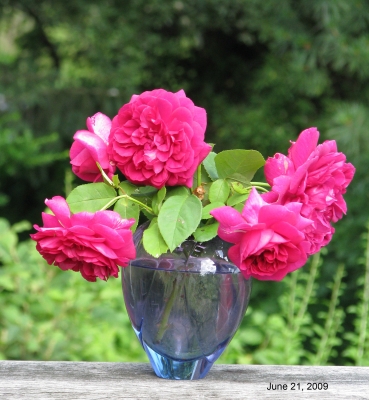 After a few years of watching the weakened plant recover each season, I made cuttings from some of the stems. The cuttings rooted and the new plants, rather than being grafted, were then growing on their own roots. Even a cold winter wouldn’t kill the roots, living in soil where temperatures are moderated. If the stems died back to ground level, new sprouts would still sport those dark, red blossoms.
After a few years of watching the weakened plant recover each season, I made cuttings from some of the stems. The cuttings rooted and the new plants, rather than being grafted, were then growing on their own roots. Even a cold winter wouldn’t kill the roots, living in soil where temperatures are moderated. If the stems died back to ground level, new sprouts would still sport those dark, red blossoms.
 Putting up the net always brings the words of fruit breeder Dr. Elwyn Meader to mind. When I visited him back in the 1980s, the old New Englander, still active in his retirement and growing about an acre of blueberries, among other crops, recounted in his slow, New Hampshire accent, “It takes a patient man to net an acre of blueberries.” Covering my two plantings encompassing a total of about a thousand square feet always creates a little tension.
Putting up the net always brings the words of fruit breeder Dr. Elwyn Meader to mind. When I visited him back in the 1980s, the old New Englander, still active in his retirement and growing about an acre of blueberries, among other crops, recounted in his slow, New Hampshire accent, “It takes a patient man to net an acre of blueberries.” Covering my two plantings encompassing a total of about a thousand square feet always creates a little tension.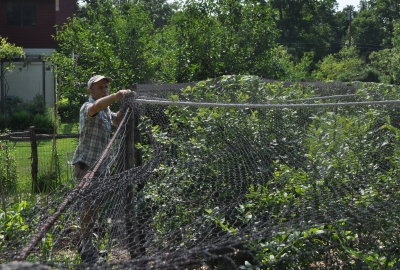 I now feel like a captain setting sail on an old sailing vessel, with all the sails trim and masts set. Except rather than sails and masts, it’s a blueberry net that’s spread tightly over the permanent, 7-foot-high perimeter of locust posts and side walls of anti-bird, plastic mesh. That netting covers 16 bushes within a 25 foot by 25 foot area. Rebar through holes near the tops of the locust posts keeps that side wall mesh taught and 18” high chicken wire along the bottom keeps rabbits, which love to teethe on that plastic mesh, from doing so.
I now feel like a captain setting sail on an old sailing vessel, with all the sails trim and masts set. Except rather than sails and masts, it’s a blueberry net that’s spread tightly over the permanent, 7-foot-high perimeter of locust posts and side walls of anti-bird, plastic mesh. That netting covers 16 bushes within a 25 foot by 25 foot area. Rebar through holes near the tops of the locust posts keeps that side wall mesh taught and 18” high chicken wire along the bottom keeps rabbits, which love to teethe on that plastic mesh, from doing so.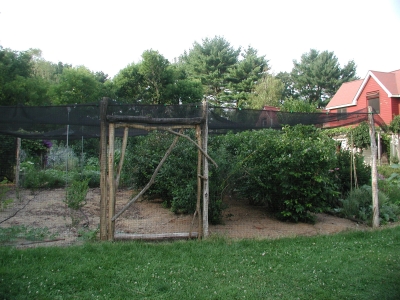 Don’t worry about the birds. They get their fill of berries elsewhere. I don’t net my lowbush blueberries, nor my mulberries or gumis. Birds don’t usually share the mulberries or gumis with me. This year, for some reason, they are sharing.
Don’t worry about the birds. They get their fill of berries elsewhere. I don’t net my lowbush blueberries, nor my mulberries or gumis. Birds don’t usually share the mulberries or gumis with me. This year, for some reason, they are sharing. Juneberries are related to apples and pears, not blueberries, and share some of their kin’s pest problems. Especially in my garden. They’re one fruit that didn’t grow well for me so, years ago, I finally dug the plants up.
Juneberries are related to apples and pears, not blueberries, and share some of their kin’s pest problems. Especially in my garden. They’re one fruit that didn’t grow well for me so, years ago, I finally dug the plants up.
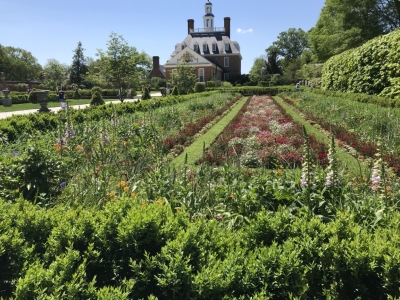
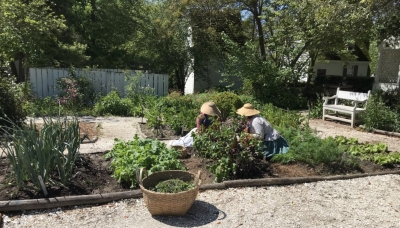 Flowering meads of herbs, flowers, and grasses blanketed the ground beneath most of the orchards, providing — probably unknown back in colonial days — forage for beneficial insects to help protect crop plants.
Flowering meads of herbs, flowers, and grasses blanketed the ground beneath most of the orchards, providing — probably unknown back in colonial days — forage for beneficial insects to help protect crop plants.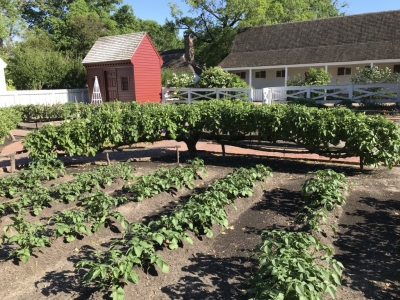
 My own home is brick; even a few four-foot-high walls around my vegetable garden and in other areas would improve the general appearance — and provide, warmer microclimates for cold-tender plants or early harvests. Not that the rustic locust fencing and arbors enclosing my vegetable garden look unsightly . . . but I’d like some brick walls.
My own home is brick; even a few four-foot-high walls around my vegetable garden and in other areas would improve the general appearance — and provide, warmer microclimates for cold-tender plants or early harvests. Not that the rustic locust fencing and arbors enclosing my vegetable garden look unsightly . . . but I’d like some brick walls.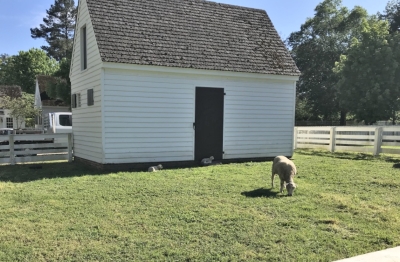
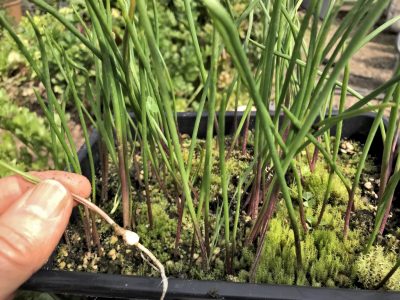 “Knowing what a bulb really is makes it easier to understand how they can multiply so prolifically that their flowering suffers, and how to get them to multiply for our benefit. Dig up a tulip or daffodil and slice it through the middle from the tip to the base. What you see is a series of fleshy scales, which are modified leaves, attached at their bases to a basal plate, off of which grow roots—just like an onion (but, in the case of daffodil, poisonous!). The scales store food for the bulb while it is dormant.
“Knowing what a bulb really is makes it easier to understand how they can multiply so prolifically that their flowering suffers, and how to get them to multiply for our benefit. Dig up a tulip or daffodil and slice it through the middle from the tip to the base. What you see is a series of fleshy scales, which are modified leaves, attached at their bases to a basal plate, off of which grow roots—just like an onion (but, in the case of daffodil, poisonous!). The scales store food for the bulb while it is dormant.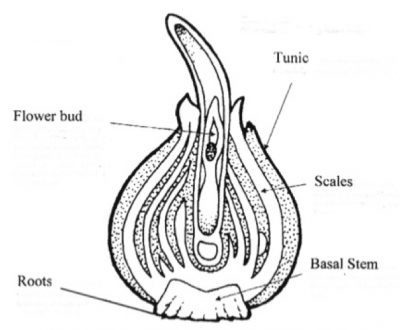 Look at where the leaves meet the stems of a tomato vine, a maple tree—any plant, in fact—and you will notice that a bud develops just above that meeting point. Buds likewise develop in a bulb where each fleshy scale meets the stem, which is that bottom plate. On a tomato vine, buds can grow to become shoots; on a bulb, buds can grow to become small bulbs, called bulblets. In time, a bulblet graduates to become a full-fledged bulb that is large enough to flower.”
Look at where the leaves meet the stems of a tomato vine, a maple tree—any plant, in fact—and you will notice that a bud develops just above that meeting point. Buds likewise develop in a bulb where each fleshy scale meets the stem, which is that bottom plate. On a tomato vine, buds can grow to become shoots; on a bulb, buds can grow to become small bulbs, called bulblets. In time, a bulblet graduates to become a full-fledged bulb that is large enough to flower.” Another way is to score the bottom plate with a knife into 6 pie shaped wedges, making each score cut deep enough to hit that growing point.
Another way is to score the bottom plate with a knife into 6 pie shaped wedges, making each score cut deep enough to hit that growing point.  After scoring or scooping, set the bulb in a warm place in dry sand or soil for planting outdoors in a nursery bed in autumn.
After scoring or scooping, set the bulb in a warm place in dry sand or soil for planting outdoors in a nursery bed in autumn. After a year, as many as 60 bulblets might be sprouting from the base of each scooped or scored bulb. Each bulblet does take 4 or 5 years to reach flowering size, but no matter. To quote an old Chinese saying: ‘The longest journey begins with the first step.’”
After a year, as many as 60 bulblets might be sprouting from the base of each scooped or scored bulb. Each bulblet does take 4 or 5 years to reach flowering size, but no matter. To quote an old Chinese saying: ‘The longest journey begins with the first step.’”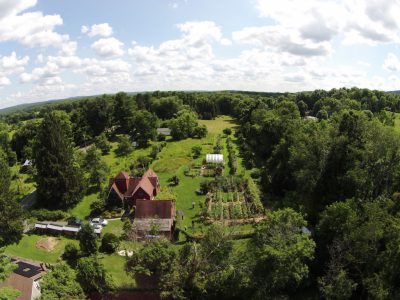

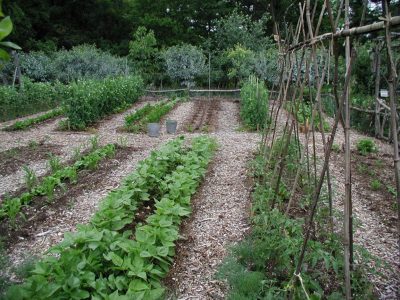 And what about winter? A greenhouse full of salad and cooking greens solved that problem, in addition to providing figs in summer and early and late season cucumbers.
And what about winter? A greenhouse full of salad and cooking greens solved that problem, in addition to providing figs in summer and early and late season cucumbers.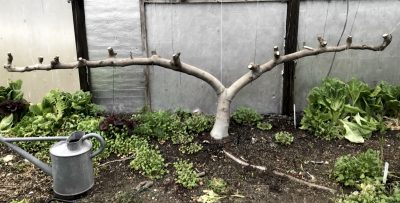
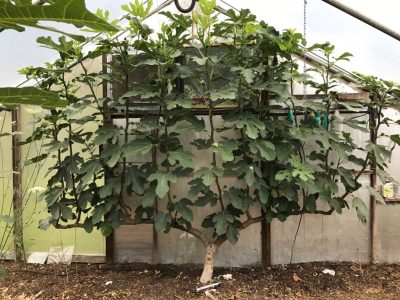
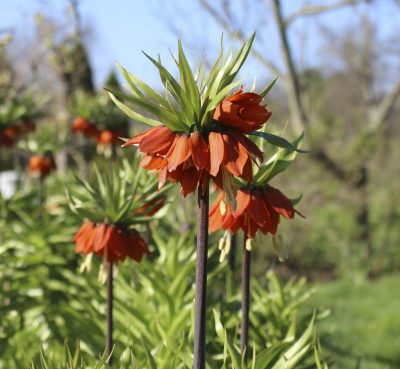
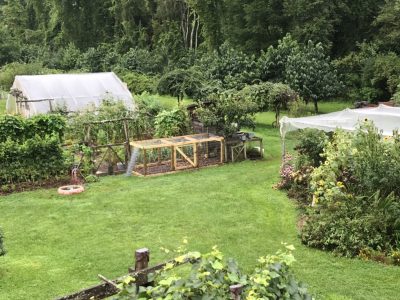


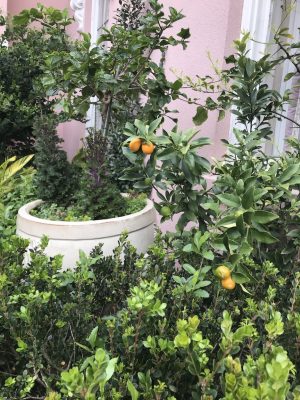 But winter low temperatures in Charleston rarely dip even to freezing but kumquat trees are hardy into the ‘teens. A few citrangequats — trigeneric hybids of kumquat, trifoliate orange, and sweet orange — that I stole from a tree proved to be tasty with sweet, edible rind enclosing a pleasingly tart interior.
But winter low temperatures in Charleston rarely dip even to freezing but kumquat trees are hardy into the ‘teens. A few citrangequats — trigeneric hybids of kumquat, trifoliate orange, and sweet orange — that I stole from a tree proved to be tasty with sweet, edible rind enclosing a pleasingly tart interior.